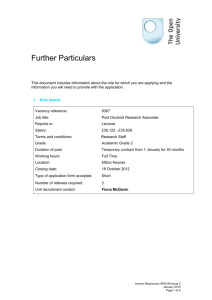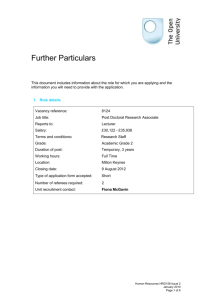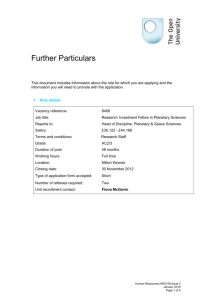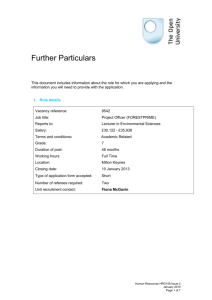Further Particulars HRG158
advertisement
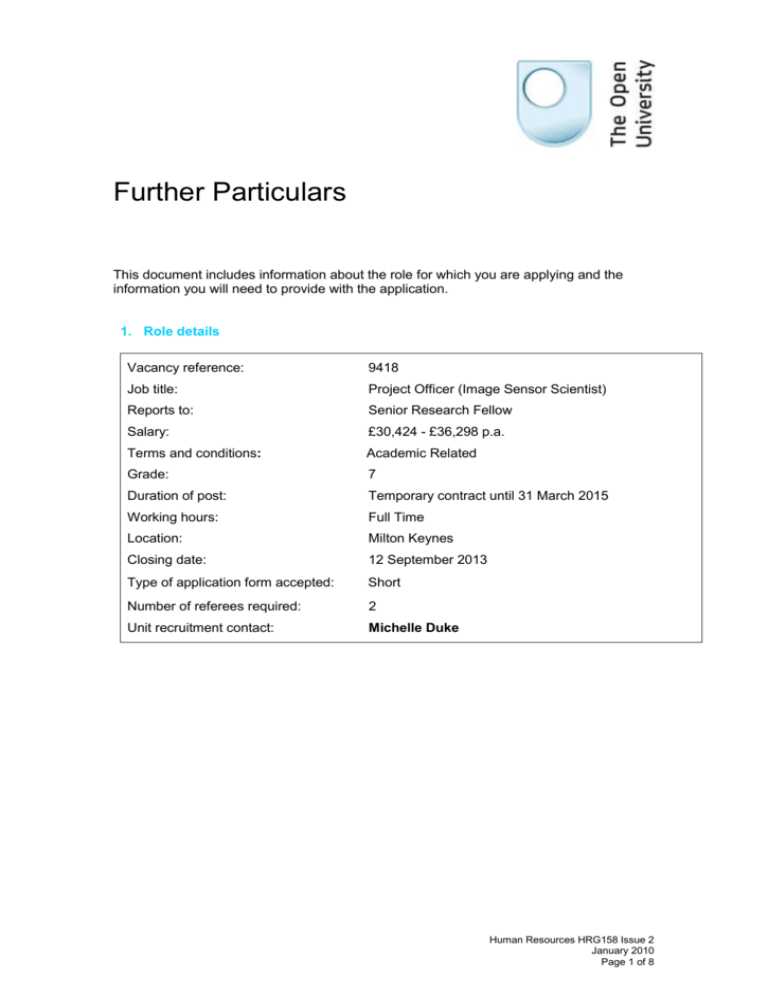
Further Particulars This document includes information about the role for which you are applying and the information you will need to provide with the application. 1. Role details Vacancy reference: 9418 Job title: Project Officer (Image Sensor Scientist) Reports to: Senior Research Fellow Salary: £30,424 - £36,298 p.a. Terms and conditions: Academic Related Grade: 7 Duration of post: Temporary contract until 31 March 2015 Working hours: Full Time Location: Milton Keynes Closing date: 12 September 2013 Type of application form accepted: Short Number of referees required: 2 Unit recruitment contact: Michelle Duke Human Resources HRG158 Issue 2 January 2010 Page 1 of 8 2. Summary of duties The e2v Centre for Electronics Imaging (CEI) is a research centre within the Department of Physical Sciences at the Open University. The CEI is collaboration between the Open University and e2v Technologies Plc., a world-leading manufacturer of scientific and industrial image sensors. The CEI is dedicated to conducting research into advanced imaging technologies for science applications and provides knowledge exchange between UK industry and academia. JUICE (JUpiter ICy moons Explorer http://sci.esa.int/juice/) is a major forthcoming space mission by the European Space Agency to study Jupiter and its moons Ganymede, Europa and Callisto. One of the instruments onboard JUICE is JANUS, a high resolution camera operating in the visible band. The UK Space Agency (UKSA) has approved funding for the CEI to lead the UK effort for the characterisation of a new CMOS image sensor and supply fully qualified devices to the JANUS consortium. The sensor, named CIS115, will be designed and manufactured by e2v Technologies. This type of CMOS image sensor has no flight heritage and requires detailed characterisation to obtain high level of confidence that it will perform well in the challenging radiation environment in the Jovian system. This post is the first position to be created at the CEI to work on the sensor for JANUS. The job holder will be engaged in all aspects of the electro-optical and radiation characterisation of the new CMOS sensor, and is expected to become a key expert in its operation and performance. The work will involve detailed electro-optical characterisation of non-irradiated sensors, performing high energy sensor irradiation similar to the expected environment around Jupiter and evaluating the performance of the devices subjected to radiation damage effects. The job holder will also attend regular project meetings, deliver progress reports and interface with team members and external scientists and engineers. Main Duties Build and commission the experimental set-up for laboratory testing of CIS115 image sensors. Establish reliable and repeatable performance under cooling for testing with light and X-rays. Carry out complete electro-optical characterisation of a number of CIS115 sensors, including responsivity, noise, dark current, quantum efficiency, full well capacity, dynamic range, linearity, modulation transfer function and image lag. Perform proton, electron and gamma irradiations of CIS115 in order to simulate the conditions in an orbit in the Jupiter system. Carry out electro-optical characterisation of irradiated CIS115 sensors and evaluate the change of performance. Propose and implement techniques to mitigate the effects from radiation damage. Build a full picture of the detector performance with the view of becoming a key detector expert for the JANUS collaboration. Dissemination of the results of the research as the work progresses. Attend regular project meetings, report progress verbally and in written form. Promote knowledge and technology exchange with e2v. Other Duties All staff are expected to: Comply with the University’s Health and Safety and Equal Opportunities policies in the performance of their duties. Take reasonable care of the health and safety of themselves and that of any other person who may be affected by their acts or omissions at work. Human Resources HRG158 Issue 2 January 2010 Page 2 of 8 Co-operate with the Open University in ensuring as far as is necessary, that Statutory Requirements, Codes of Practice, University Policies and Departmental Health and Safety arrangements are complied with. Have a strong commitment to the principles and practice of equality and diversity. Attend appropriate staff development events. 3. Person specification Essential: BSc in electronic engineering or a related subject Good understanding and experience in characterisation of image sensors, proficiency with data acquisition systems and data processing software, experience with vacuum and cryogenic equipment. Good problem solving and analytical skills, demonstrated logical and rigorous approach to work. Demonstrated ability to work both as part of a team and on own initiative. Ability to plan own work, prioritise workload and to deliver results on schedule. Strong verbal and written communication in a team environment and good presentation skills. Ability to communicate effectively with colleagues from a wide range of backgrounds. Excellent work ethics. Desirable: MSc or PhD in electronic engineering or a related subject Electro-optical characterisation of CMOS image sensors, knowledge of radiation damage effects in semiconductors, knowledge of electronics. 4. Role specific requirements e.g. Shift working 5. About the unit/department Faculty of Science The Faculty has a staff of about 270, comprising of around 115 academic staff (central and regional/national) with the balance made up of research staff, curriculum managers, laboratory staff, administrators and clerical staff. There are also varying numbers of research students and visiting academic staff. The Faculty has three departments, each with constituent discipline groups: Department of Environment, Earth and Ecosystems Earth Sciences Ecosystems and Biodiversity Department of Life, Health and Chemical Sciences Brain & Behavioural Sciences Cell & Molecular Biology Chemistry & Analytical Sciences Human Biology Department of Physical Sciences Human Resources HRG158 Issue 2 January 2010 Page 3 of 8 Astronomy Physics Planetary & Space Sciences Curriculum The Faculty has developed an extensive range of modules using the Open University's supported open learning teaching model. These modules contribute to a number of qualifications such as the BSc (Hons) Natural Sciences and the more general BSc (Open) degree. In addition, the Faculty supports a number of diplomas and certificates including interdisciplinary offerings with other faculties. Students can choose to study any of our modules and qualifications at their own pace and are supported by tutors, study advisers and on-line conferences. There are optional face to face tutorials for some modules, but many of our modules are accessible entirely online and it is possible to complete the whole Natural Sciences BSc degree in this way. This level of accessibility means that the Faculty supports a large proportion of all the part-time undergraduate degree studies undertaken in the UK. In addition to our degree level programmes, the Faculty offers an innovative range of Science Short Courses that are designed to provide a taster of Level 1 study for those new to undergraduate study. The Faculty also offers a Master's postgraduate degree programme with several taught degrees including the first UK MSc to be accredited by the Council of Graduate Schools as a Professional Science Master's. The launch of a new suite of modules in Practical Science (S288) in February 2012 sees an exciting opportunity for engaging in practical science through online environments and laboratory and field-based activities. The five modules reflect each of the five major disciplines: chemistry and analysis (SXC288); environmental science (SXE288); earth and environment (SXG288); biology and health (SXL288) and physics and astronomy (SXP288). Two promotional videos outlining these new modules are available to view - S288 Practical Science. Research & Enterprise Our research encompasses a wide range from 'blue skies' to applied research finding solutions to specific scientific and technological problems.. These research activities are supported by world class laboratory facilities and instrumentation and provide opportunities for full time PhD research studentships supported by our own academics and post-doctoral researchers. There are about 48,000 students studying our undergraduate and postgraduate science modules, mainly based in the UK, but increasing numbers are studying online globally. There are also several hundred PhD research students studying full time in our laboratories at our campus in Milton Keynes or part time at partner institutions or affiliated research centres. We have over 4500 square metres of state-of-the-art research laboratories with major research facilities that include: A recently opened facility for interdisciplinary research in ecosystems and geobiology. One of Europe’s leading centres for isotope mass spectrometry including extensive radiogenic, noble gas and stable isotope mass spectrometry facilities and a new £3 million microbeam facility, including a Cameca Nanosims ion imaging system and dual beam FIB-SEM Ultraclean spacecraft instrument testing and assembly, and for handling planetary Human Resources HRG158 Issue 2 January 2010 Page 4 of 8 materials and returned extra-terrestrial samples A state-of-the-art life sciences research facility including biological containment laboratories, molecular genetics and DNA-sequencing laboratories Environmental and transmission electron microscopy Hypervelocity Impact laboratory Well-equipped laboratories for research in atomic, molecular and plasma research The Faculty of Science undertakes a range of research across many scientific topics, bringing together traditional scientific disciplines and new interdisciplinary areas through three major research groupings: Centre for Earth, Planetary, Space and Astronomical Research (CEPSAR) CEPSAR aims to explore origins, systems and processes with respect to the evolution and chemistry of materials that form the stars and planetary bodies, the processes and natural systems that shape the environment of our habitable world, and the essential properties of a Solar System that allows life to develop on one of its planets. Research in CEPSAR is focused on 6 strategic research themes: Astronomy Environmental Change (Past, Present and Future) Natural Hazards Planetary Geosciences Geochemistry and Cosmochemistry Solar System Exploration A priority for CEPSAR's research is to investigate issues that are at the cutting-edge of science, are topical, with practical outcomes to Earth dwellers and planetary investigators. Our research will supply knowledge that ensures continued and improved habitability of our planet by a better understanding of its processes (past, present and future). All this is set within a period of rapid environmental change (the next 10 years may prove crucial for Earth) that may influence the lives of our children and future generations. Research in CEPSAR is currently supported through a variety of external funding including from ESA, NERC, STFC, The Wellcome Trust and The Leverhulme Trust. If you would like any further information please visit our website at CEPSAR. Biomedical Research Network Our research in the Life Sciences aims to investigate the properties and interrelationships of organisms, including humans, other animals and plants – covering different levels of biological organization, from molecules to communities of organisms. Current research priorities are: Ageing and neurodegeneration Autism Biodiversity and environmental science Biological and health-related physics Bio-organic and medicinal chemistry Cell biology and immunology of the nervous system Cellular and molecular neurobiology Cognitive Science Molecular genetics Neuroscience Human Resources HRG158 Issue 2 January 2010 Page 5 of 8 Our research teams comprise biologists, chemists, environmental scientists, physicists and psychologists who contribute to a vibrant and interdisciplinary research community. Our laboratory facilities have recently been substantially expanded and include molecular genetics laboratories, a DNA-sequencing laboratory, dark rooms, tissue culture suites, electron microscopes, confocal microscope suite, ecology labs, biology resource unit and a radiation suite which houses a cell harvester, beta scintillation and gamma counters. If you would like any further information about biomedical research at The Open University please visit our website at BRN. Employers, Science, Technology, Engineering, Entrepreneurship, Mathematics (eSTEeM) eSTEeM brings together STEM academics to promote innovation and scholarship. We are working in four priority areas: Education for employment – working with employers, sector skills councils, professional bodies, HE STEM agencies etc. International STEM education – promoting conversations about international challenge in supply of STEM graduates, associated teaching and learning models, and scholarship opportunities. Engagement – promoting innovation, development and associated scholarship. Enterprise – identifying opportunities to use Open University expertise in STEM education in spin-out activities and resources. Much of our work centres on the effective use of learning technologies at scale - our portfolio of projects includes work on e-assessment, mobile learning, online laboratories and the use of virtual learning environments. We welcome partnerships and are already working with universities and other agencies both within and outside the UK. Further information on the Faculty can be found on our website at http://www8.open.ac.uk/science/main/. Department of Physical Sciences Head of Department: Professor Monica Grady The Department of Physical Sciences (DPS) is a lively and innovative department of around 150 staff and postgraduate research students drawn from across the globe. DPS has grown from the merger of the former Department of Physics and Astronomy with the Planetary and Space Sciences Research Institute and the Planetary Surfaces Group from the former Department of Earth and Environmental Sciences. The Department comprises three Disciplines: Astronomy (Head: Dr Stephen Serjeant) Physics (Head: Professor Nick Braithwaite) Planetary and Space Sciences (Head: Professor Ian Wright) The Department’s research is co-ordinated through the Centre for Earth, Planetary, Space and Astronomical Research (CEPSAR) http://cepsar.open.ac.uk/, and covers a wide range of subjects – from the behaviour of atoms at temperatures close to absolute zero to the merger of galaxies many light years away. Studies range from the building blocks of stars and planets by microscopes, and stars and planets themselves by both Human Resources HRG158 Issue 2 January 2010 Page 6 of 8 ground- and space-based telescopes. The common thread that runs through research in these areas is a desire to understand the origin of matter, and how it has evolved from the Big Bang almost 14 billion years ago to what we can observe and measure today. There are several research groups lead by staff in DPS including the Centre for Electronic Imaging (CEI), the Cold Atoms Group, the Cosmochemistry Research Group (CRG), the Exoplanets Group and the Planetary Surfaces and Atmospheres Group (GASP). The Department enjoys full use of CEPSAR’s exceptionally well equipped research facilities and has an unparalleled suite of analytical instrumentation in modern laboratories on campus; this is complemented by the regular use of multi-national facilities such as the Diamond synchrotron, the European Southern Observatory, the Hubble Space Telescope, the Herschel Space Observatory, the James Clerk Maxwell Telescope, and many other facilities. The Department’s teaching is mainly within the Physical Science curriculum, with additional significant contributions to the Geoscience strand. DPS are also major drivers of the Science Faculty’s flagship introductory science course, Exploring Science (S104), and its new second level practical science courses, Practical science: physics and astronomy (SXP288) and Practical science: Earth and environment (SXG288). For more information on the e2v Centre for Electronic Imaging, please see the website. 6. How to obtain more information about the role or application process If you would like to discuss the particulars of this role before making an application please contact Dr Konstantin Stefanov on +44 (0)1908 332 116 or email konstantin.stefanov@open.ac.uk. If you have any questions regarding the application process please contact the Science Staffing Team on +44 (0)1908 654 765 or email science-recruitment@open.ac.uk. 7. The application process and where to send completed applications Please ensure that your application reaches the University by: 12 September 2013 Please e-mail your application to science-recruitment@open.ac.uk or post it to: Name/Job title: Michelle Duke Department/Unit: Staffing Team, Faculty of Science Address: Walton Hall Milton Keynes Post Code: MK7 6AA 8. Selection process and date of interview Your application should consist of a completed short application form, CV and covering letter. The closing date for applications is Thursday 12 September. The interview panel will be chaired by Dr KonstantineStefanov Other panel members will be advised following shortlisting. Human Resources HRG158 Issue 2 January 2010 Page 7 of 8 The interview date is to be arranged. Further details on the selection process will also be sent to shortlisted candidates. We will let you know as soon as possible after the closing date whether you have been shortlisted for interview. Further details on the selection process will also be sent to shortlisted candidates. Applications received after the closing date will not be accepted. Human Resources HRG158 Issue 2 January 2010 Page 8 of 8
